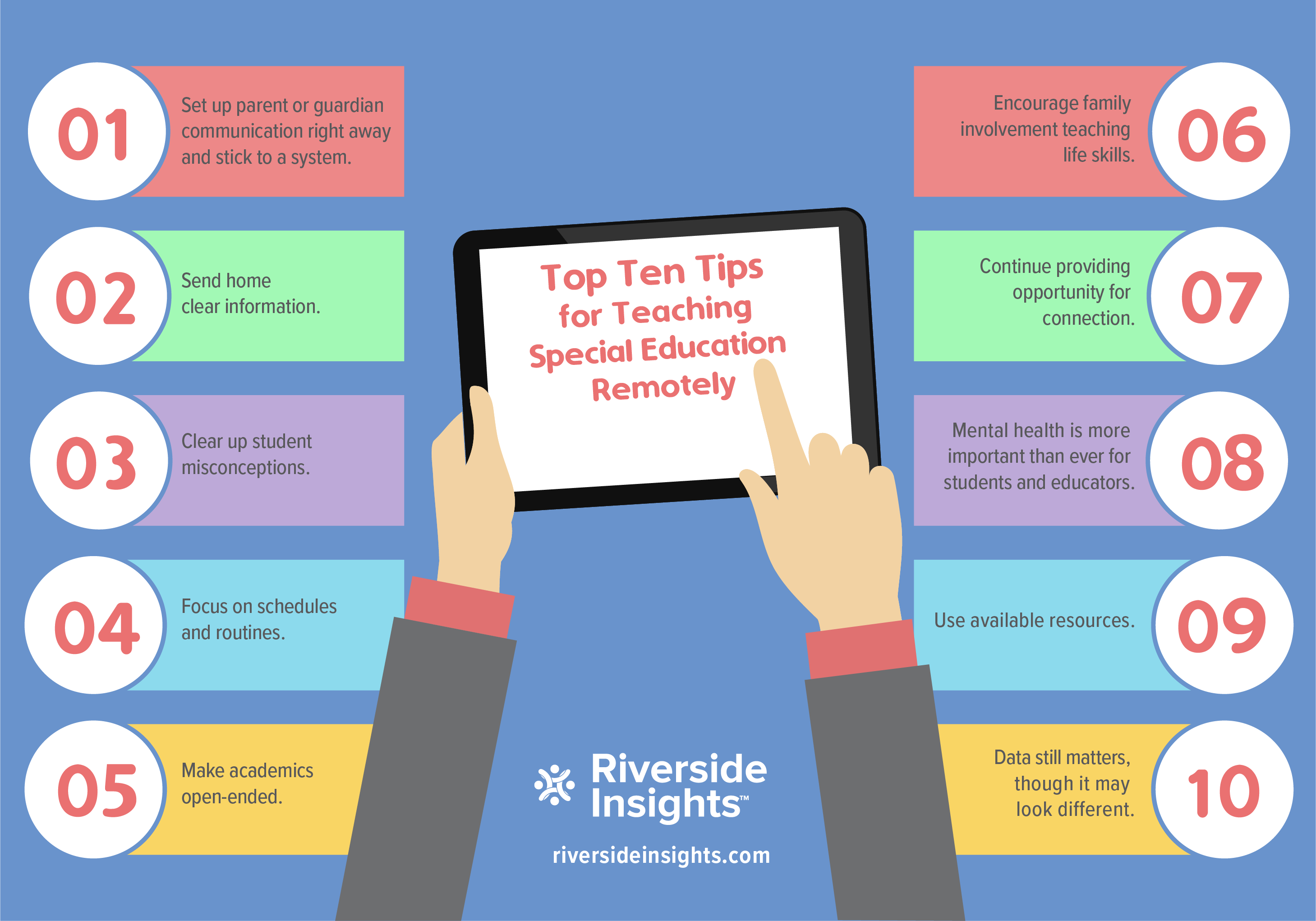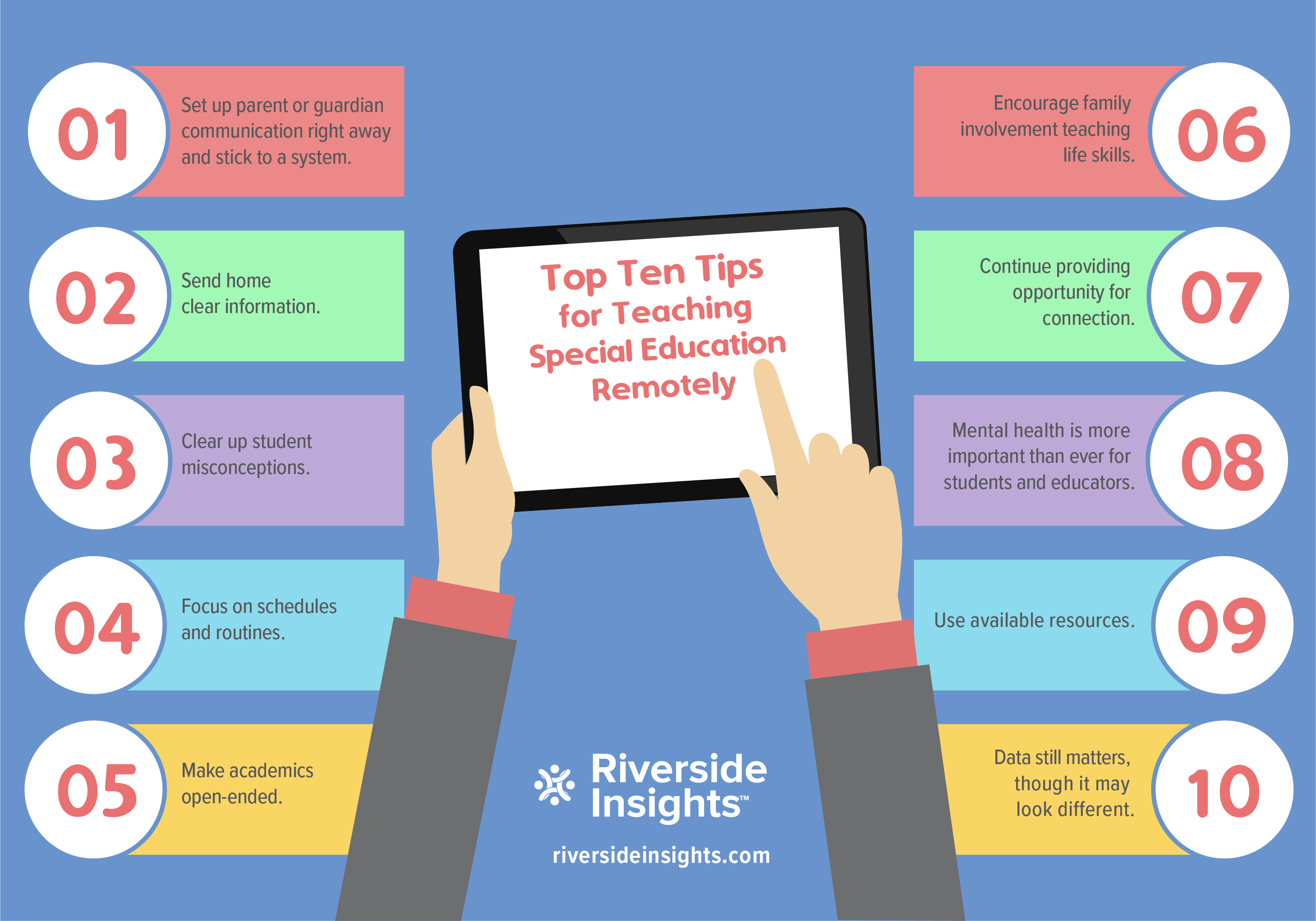
Previously, I shared six of ten tips for teaching special education remotely. Below are the last four tips in the series “10 Tips for Teaching Special Education Remotely.”
7) Continue providing opportunity for connection.For some students, our classrooms are their only safe place. It is so important to continue to try to connect with students, either through Google Voice, Zoom, email, or even writing a letter if there are no other options. Students also need to connect with each other, which is often difficult for our students who struggle with social skills on a regular day, let alone during a pandemic. Google Classroom and Zoom offer a good way for students to be social with each other and share their work. Students who use assistive technology to communicate can participate in these kinds of conversations as well with family help. I have had some of my old students reach out to connect because they are scared and bored. Show students that just because their world is changing, they can still rely on you. Talking to you and other classmates may be the only interaction the student has outside of their immediate family, so it is great to talk about topics like Netflix shows they are watching in addition to academics. We can also use these conversations to continue to monitor kids who could possibly be in dangerous home situations. Even if real time connection proves to be a challenge, prerecorded videos have also been wonderful for students to see their teachers. For example, one of the schools I previously taught at has been uploading daily Facebook videos of school staff doing activities and reading books in order to reach their students with severe and multiple disabilities with great success.
8) Mental health is more important than ever for students and educators.
I am a big proponent of incorporating mental health and self-care activities in to our daily teaching practice, and many can be done remotely. At the very least you can provide students and their families with ideas for self-care. You can create a self-care choice board or menu. You can encourage student journaling and mindfulness practices like breathing exercises. Some students may need sensory items in order to relax. My students would roll their eyes at my meditation videos at first but eventually loved them and asked for more. There are tons on YouTube! Please don’t forget about yourself, as well; juggling teaching with taking care of your family and your own worry is no small task. The best self-care you can do right now is set limits; you cannot work around the clock and be a successful teacher. My personal favorite self-care activity is a face mask and a bath while hiding from my one-year-old, but to each their own.
- A social story for elementary students to fill-in and color from the Center for Disease Control
- A workbook for students to help cope emotionally with COVID-19
- A document you could use to plan discussions or activities with high school students from the National Child Traumatic Stress Network
- Activity ideas for children that could foster family togetherness and positivity
- Ideas for sensory activities at home
- Simple mindfulness activities for children
- A meditation experience from Oprah and Deepak Chopra that I use myself
Now is the time to exemplify the old saying “don’t reinvent the wheel.” There are so many resources online; you just have to find them. Working with other teachers will make it easier to plan content and provides connection with others. Many popular websites are offering free access until the end of the school year.
- A comprehensive list of learning websites
- A large group of curated resources for special education, from webinars to websites
- Websites great for reading activities:
- The best list of math resources I have found
- Free Boardmaker resources for schedules, social stories, etc.
- News-to-You is offering free trials to all right now
- BrainPOP
- A helpful webinar for teaching special education online
- Department of Education resources
- An article with immediate ideas for setting up remote teaching
- A comprehensive guide for helping students with autism spectrum disorders during COVID-19
“Show students that just because their world is changing, they can still rely on you.”
10) Data still matters, though it may look different.
It is still essential to use data to inform your instruction and create remote learning materials that are appropriate for the levels of your students. Now would be a great time to dive in to data from assessments such as easyCBM and catch up on progress monitoring or to assess if your interventions were working. I also challenge you to use qualitative data to inform your teaching right now. For example, are kids showing up to your Zoom meetings? Are students turning in projects? Asking you questions? Wanting to connect? Of course they could not be doing these things due to individual circumstances we discussed in the beginning of this article. Or, perhaps it is time to change a few things. Do you need to provide more fun activities in your choice boards? Do you need to communicate more with parents or guardians? Do you need to change up how you are assigning reading? Let the students’ “vibe” be your guide in this uncharted territory. Visit Riverside Insights’ COVID-19 Resource pages for guidance on using assessments during this time, including:
- Information on administering the Battelle Developmental Inventory, 2nd Edition, Normative Update (BDI-2 NU) during this time
- Information on administering the Woodcock-Johnson IV Tests of Cognitive Abilities and Tests of Achievement during this time
While teaching special education remotely is difficult, we can put procedures in place and create new routines in order to provide stability for our students from afar. By focusing on these things we can operate out of a place of calm instead of panic. Students catch on to our attitude and will respond in kind. Our hardest job may be when we return to schools and we will have to pivot to meet kids where they are.
Have you found any excellent resources for teaching special education remotely? Please share any of your ideas or best practices.





